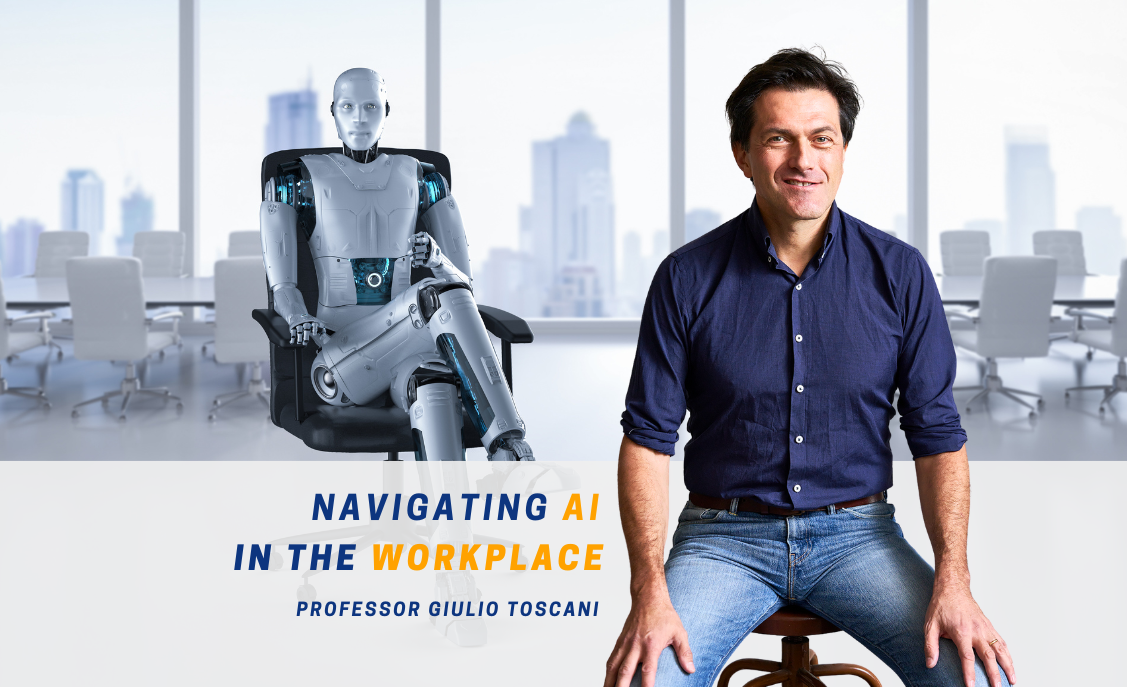Why it’s key for your organization to have an AI plan including transparent policies, manager upskilling and human oversight.
Like smartphones and the advent of the internet before it, the rise of modern artificial intelligence (or at least, miasmas of it) promises to bring greater efficiency and insights to the workplace.
But as companies like the Getty Images sue generative AI platforms for copyright infringement, the legality of machine-generated content starts to pose a liability to companies looking to integrate AI into their workflow. When it comes to AI, questions about data quality, output coherence and ethical considerations are being grappled with across institutions.
Giulio Toscani, PhD, is a digital strategy academic at ESADE Business & Law School in Barcelona, Spain. Professor Toscani says managers must become adept at understanding the changes AI brings to the workplace, in order to develop systems to ensure it is used transparently and safely.
The three-pronged approach
Effectively managing the AI shift requires finesse in blending automated systems with human skills and oversight, says Professor Toscani. He recommends that managers craft explicit guidelines for AI utilization, focusing on three foundational components:
- Asking the right questions
- Understanding the domain
- Fostering a culture of sharing data
To explain how this could play out, he gives an example of a retail company using AI for its inventory management.
“Asking questions involves clearly outlining the challenges the AI system aims to address, such as optimizing stock levels and reducing wastage. Understanding the domain entails ensuring that the AI system understands the intricacies of the retail industry, including seasonal trends and supplier dynamics. Lastly, sharing data involves creating channels for regular communication between the AI experts and the operational teams to exchange insights and refine the AI system based on real-world experiences within the retail domain,” he explains.
Know your data, know your AI
The opaque logic behind most generative AI software makes quality assurance a challenge for workers and managers alike. Professor Toscani says building the right processes incorporating both human and machine components will be key to effective decision-making.
“Assessing the value of AI-generated reports and recommendations, with a particular emphasis on scrutinizing the sources, is essential prior to decision-making. Consider this process as refining the collaboration between humans and AI to achieve the best possible results.”
Some managers have already implemented structured workflows and training programs to enhance their ability to identify reliable insights, he says.
This human-machine collaboration can potentially supercharge outcomes.

“Before making strategic decisions based on AI-generated reports, they meticulously evaluate the quality and credibility of the data sources, ensuring that the collaboration between human expertise and AI algorithms produces accurate and beneficial outcomes.”
Managers must upskill to keep pace
Upskilling will be key to navigating the AI effect on workflows. Managers must not only be adept at classic leadership abilities but must also gain a deep understanding of AI capabilities, including both its limitations and implications for decision-making, says Professor Toscani.
“The ability to foresee future developments and break down organizational silos is crucial. A manager might need to anticipate how integrating AI into customer service could impact team dynamics and customer interactions,” he says.
He adds that such managers must be able foresee potential challenges, such as resistance from employees or ethical concerns, and proactively address them to ensure a smooth transition.
Data is already flowing in demonstrating the AI bonus on productivity – one study from MIT researchers looked at the quality and productivity benefits accrued in 444 business professionals who were tasked to produce a business report with and without ChatGPT. A 59 percent productivity improvement across the board was observed, including a higher quality of the reports that were made with AI.
Several compelling instances exist where organizations effectively employed AI for data analysis and personalization, notes Professor Toscani.
“For instance, consider coursera.org, which provides the opportunity to utilize a chatbot for overseeing course materials. Another example is replika pro, which offers a chatbot companion for meaningful conversations and understanding. Users are willing to engage and pay for it. The key shared element in these successful cases is the implementation of a strategic approach, aligning AI initiatives with specific business objectives. Moreover, these organizations ensure that the integration of technology complements human expertise rather than substituting it entirely.”
Managers must be ready for changes in workflows and skill demands, particularly in areas such as marketing, sales, and product development, he emphasizes.
The evolution of HR in the AI age
As AI handles routine tasks, the manager-employee relationship is set to evolve, freeing managers up to concentrate more on strategic thinking and interpersonal skills. But one rung of a company that will see significant change is human resources.

“A new type of human resources will emerge, responsible for allocating tasks to both humans and machines. These professionals will navigate the delicate balance of determining when human training is needed and when it’s time to replace or upgrade machines,” says Professor Toscani.
In a manufacturing setting, for example, a manager overseeing the integration of AI in production processes must navigate how AI can optimize routine tasks like quality control. This requires redefining the roles of human workers, fostering collaboration with AI systems, and identifying opportunities for human skill development to enhance overall efficiency.
Professor Toscani points to the rise of “hybrid” human resources roles optimized for both human and AI collaboration. For instance, production managers must determine when to utilize automated quality control versus human inspection. In the process, they will have to redefine the role of human workers, foster collaboration with AI systems and identify opportunities for human skill development.
The ethical and legal challenge
In addition to copyright, AI raises other issues for managers to consider. Professor Toscani says these range from biases to concerns about privacy and opacity in decision-making processes.
He cites the example of Sam Altman’s ouster from and return to OpenAI, noting how this reveals internal conflicts and philosophical tensions at the highest echelons.
“While overarching philosophical debates may take place at the executive level, it is imperative to recognize the pivotal role that middle managers play in the day-to-day implementation and oversight of AI systems. To address and mitigate these ethical quandaries, managers at this level can institute robust review processes that scrutinize the ethical dimensions of AI applications,” he says.

Transparency becomes a linchpin of this process. Managers must ensure clear communication channels about the ethical implications of AI within the organization, says Professor Toscani. “This entails not only adhering to legal frameworks but also aligning AI applications with the core values and overarching goals of the organization,” he adds.
The regulatory factor
On a practical level, managers must proactively navigate this evolving regulatory landscape, says Professor Toscani. But for now, waiting only for regulations may not be the soundest approach to AI safety.
“An analogy to consider is the historical development of automobiles: while Ford invented the car, the incorporation of safety belts was not an automatic inclusion. Similarly, relying solely on tech companies to self-regulate might be akin to expecting your hairdresser to suggest when you need a haircut—a somewhat wishful thinking exercise,” he says.
“Staying abreast of emerging regulations is essential, and a prime example of this is the European Union’s proactive stance on AI,” he adds. Returning to the car analogy, he says that managers can be akin to drivers, steering their teams towards compliance and ethical AI integration, and anticipating a future where regulations are likely to become more stringent.








